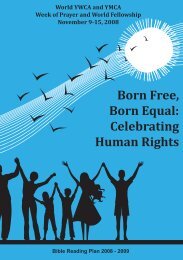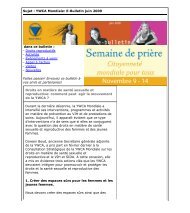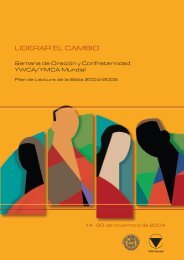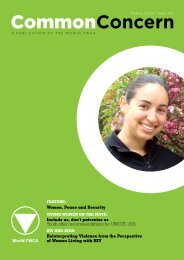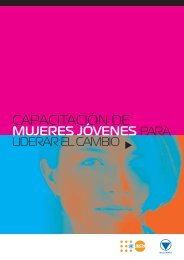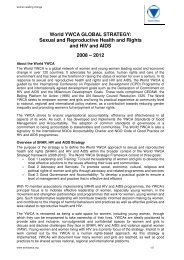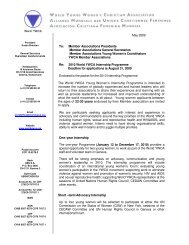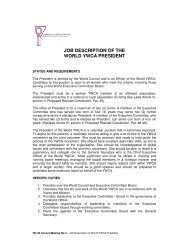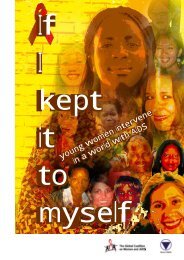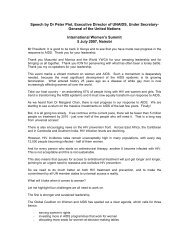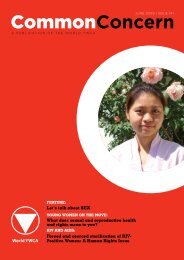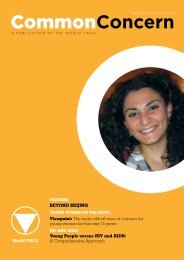World YWCA GUIDE TO STARTING A YWCA
World YWCA GUIDE TO STARTING A YWCA
World YWCA GUIDE TO STARTING A YWCA
Create successful ePaper yourself
Turn your PDF publications into a flip-book with our unique Google optimized e-Paper software.
<strong>GUIDE</strong> <strong>TO</strong><br />
<strong>STARTING</strong><br />
A <strong>YWCA</strong><br />
<strong>World</strong> <strong>YWCA</strong><br />
16 Ancienne Route, Grand Saconnex<br />
CH-1218 Geneva, Switzerland<br />
Tel: (41-22) 929 6040 Fax: (41-22) 929 6044<br />
Email: worldoffice@worldywca.org<br />
http://www.worldywca.org
CONTENTS<br />
FOREWORD 2<br />
<strong>STARTING</strong> A <strong>YWCA</strong> 3<br />
THE FIRST ELEVEN STEPS 6<br />
<strong>YWCA</strong> ORGANIZATION STRUCTURE 7<br />
ROLE OF THE EXECUTIVE COMMITTEE/BOARD 9<br />
<strong>GUIDE</strong>LINES FOR DRAWING UP<br />
A NATIONAL CONSTITUTION 10<br />
MEETINGS 11<br />
<strong>GUIDE</strong>LINES FOR PROGRAMME DEVELOPMENT 12<br />
FINANCING 15<br />
Page<br />
Page 1 of 15
FOREWORD<br />
This Guide to Starting a <strong>YWCA</strong> was developed in response to requests from groups and individuals around<br />
the world who want to start <strong>YWCA</strong>s and need guidance as to the procedures and protocol involved. The<br />
<strong>YWCA</strong> movement around the world is successful. in part because of the strong foundations on which<br />
national and local associations are built and this Guide seeks to ensure that all new <strong>YWCA</strong>s also begin with<br />
this advantage.<br />
Users of this book should note however that this Guide can only offer a basic outline. Those seeking to start<br />
new <strong>YWCA</strong>s can glean general principles from it but must adapt it to their own circumstances. There are<br />
many variations and models of structures and practices in local and national associations throughout the<br />
world, so that each new association will need to take into consideration its own ways of work together with<br />
cultural, historical and geographical factors. This flexibility within the <strong>YWCA</strong> movement is necessary for it<br />
to maintain another of its strengths, which is diversity. Nurturing unity with diversity is a gift that has<br />
allowed the <strong>YWCA</strong> to grow and evolve to meet the needs of women in 92 countries around the world.<br />
Why does someone want to start a <strong>YWCA</strong> in the first place? The answers are numerous but they almost all<br />
share the common denominator of an unmet need or a problem to be solved. When an individual woman or<br />
group observes an unmet need in their community, they soon realize that many hands can address the need<br />
better than one or a few. As a base for community organizing and coalition building, a <strong>YWCA</strong> offers that<br />
solidarity. When a woman sees that the talents of the women around her being wasted and going unused,<br />
she is seeing another need for a <strong>YWCA</strong>. The <strong>YWCA</strong> offers leadership opportunities at many levels and<br />
challenges women to use and develop their abilities in service to others. Where young people or older<br />
people lack worthwhile activities, the <strong>YWCA</strong> gives them space to create them. Where there is a spiritual<br />
void, the <strong>YWCA</strong> provides a space for spiritual fulfillment through its commitment to faith in action. Where<br />
there is a lack of freedom, the <strong>YWCA</strong> exemplifies democratic principles. <strong>YWCA</strong>s can fill many needs and<br />
provide answers to many different problems. But the ultimate initiative must come from individuals who<br />
commit themselves to making this happen.<br />
This Guide is only the first step to assist you. We wish you every success in using it and ask you to<br />
remember that the <strong>World</strong> <strong>YWCA</strong> is available to answer queries and assist in training and resource<br />
materials. As this is the first printing of this Guide, we welcome all suggestions for improvements or<br />
additions. If you translate it, please send us a copy. Best wishes for your effective work as women!<br />
Page 2 of 15
Starting a <strong>YWCA</strong><br />
1. What is the <strong>YWCA</strong>?<br />
• The <strong>YWCA</strong> is a worldwide membership movement of women committed to the empowerment of<br />
women through education and training.<br />
• It is a volunteer movement of women and girls, active in over 100 countries.<br />
• It is an ecumenical organization not connected with any church, but working in accordance with<br />
Christian principles for the benefit of women of all faiths.<br />
• It is a non-governmental organization (NGO) and a lay movement bringing together women and<br />
girls from different backgrounds into a worldwide fellowship, without distinction of race,<br />
nationality, class or religion, seeking to promote understanding and cooperation between people of<br />
different nations, races and groups.<br />
• The <strong>YWCA</strong> responds to concerns and unmet needs of women and girls through relevant<br />
programmes.<br />
• In all countries of the world, women have not been able to realize their full potential in society.<br />
Throughout its history the <strong>YWCA</strong>, as a women’s membership movement, has promoted and<br />
developed opportunities for leadership by women at local, national and international levels.<br />
• In some countries, conditions may lead to the establishment of joint <strong>YWCA</strong>-YMCA associations.<br />
In such a situation, responsible women of the <strong>YWCA</strong> should seek to identify how best they can<br />
fulfill their task as a women’s movement to maintain the identity and work of the <strong>YWCA</strong> through<br />
leadership by women while functioning within a structure which involves both men and women in<br />
policy-making decisions.<br />
2.How is a new <strong>YWCA</strong> forrmed?<br />
• Where interest in starting a <strong>YWCA</strong> has been shown by women in a community, organization of a<br />
<strong>YWCA</strong> can begin with guidance from the <strong>World</strong> <strong>YWCA</strong> headquarters (<strong>World</strong> Office) and the<br />
<strong>World</strong> Executive Committee.<br />
• The <strong>World</strong> <strong>YWCA</strong> can provide training and resource materials for:<br />
• setting up an organizational committee,<br />
• recruiting members,<br />
• developing programme plans and preparing a budget,<br />
• writing a Constitution/Bye-Laws,<br />
• interpreting the <strong>YWCA</strong> to the community,<br />
• understanding national-local relationships and the requirements for affiliation to the <strong>World</strong><br />
movement.<br />
3. How does a <strong>YWCA</strong> function?<br />
• It is primarily an organization led by volunteers, although it can employ staff to work in<br />
partnership.<br />
• It has an elected volunteer National Executive Committee* which sets policies and has other<br />
Page 3 of 15
important responsibilities. A volunteer Chairperson is elected to head the National Committee and<br />
eventually, when funding is secured, a paid General Secretary or Executive Director may be<br />
appointed who will carry responsibility for the coordination of programme and direction of staff.<br />
The Executive Committee is responsible for her appointment and terms of employment.<br />
* The specific names and titles of committees, boards and leadership positions may vary in different<br />
national associations.<br />
• Members are recruited and involved in proposing and carrying out activities that address the needs<br />
of women and girls.<br />
• In keeping with the <strong>YWCA</strong> purpose, programme plans and ways to finance such are developed.<br />
• A <strong>YWCA</strong> has a Constitution and Bye-Laws so that functions and procedures are clear. The<br />
Constitution and Bye-Laws comprise the law that govern the organization. They are adopted by the<br />
membership. They assure the organization’s permanent character, stability and democratic<br />
framework.<br />
• <strong>YWCA</strong> leaders must have a clear idea of what the <strong>YWCA</strong> is and should be able to interpret the<br />
<strong>YWCA</strong> to the community.<br />
• The <strong>YWCA</strong> works in coalition with other community organizations on common goals but it keeps<br />
its own identity.<br />
4. Does a <strong>YWCA</strong> need a building?<br />
• No, but it does need a place to meet, a mailing address, and a telephone, or access to one. These are<br />
needed to facilitate communication, establish identity and provide the means for effective<br />
administration and programme development.<br />
5. Does an association need paid staff?<br />
• No. <strong>YWCA</strong> volunteers generally carry strong roles and responsibilities. For reasons of continuity<br />
and programme development, funding is often sought to enable the appointment of part-time or<br />
full-time paid staff.<br />
6. How is a <strong>YWCA</strong> supported?<br />
A <strong>YWCA</strong> may be financed in several ways:<br />
• membership fees<br />
• programme activity fees<br />
• special fundraising events<br />
• government grants<br />
• funding from proposals to donors for specific project/programme activities<br />
• the <strong>World</strong> <strong>YWCA</strong> Resource Sharing Programme, through human and financial resources.<br />
7. How does the purpose of the <strong>YWCA</strong> translate into action?<br />
The <strong>YWCA</strong> purpose translated into action means that the <strong>YWCA</strong>, at local and national level, and in<br />
response to the needs of the community, may offer appropriate programme in such areas as<br />
• leadership training, with special emphasis on young women<br />
• community development<br />
• skill-training and educational activities for all ages<br />
• health and nutrition<br />
Page 4 of 15
• child-care and schooling<br />
• women’s rights, including action to combat violence against women<br />
• shelter/housing<br />
• environmental issues and appropriate technologies<br />
• networking with other organizations and agencies with similar goals.<br />
• human rights and peace with justice<br />
8. What is the role of the membership?<br />
Members are the key ingredients of our movement, and they are every <strong>YWCA</strong>’s greatest assets.<br />
Addressing the interests and needs of the membership is a basic element of successful programmeplanning<br />
and ensures the growth of your <strong>YWCA</strong>. Guidelines regarding membership and involvement of<br />
the membership in decision and policy-making, and implementation are essential.<br />
Page 5 of 15
The First Eleven Steps in Forming a <strong>YWCA</strong><br />
1. FORM an Organizing Committee of at least 10-20 members. Ideally these women should be from<br />
varying cultural, racial, ethnic, religious and economic groups in the community. They should also be<br />
willing to give concentrated time for further study of <strong>YWCA</strong> background materials, the process of<br />
organizing a new association, and interesting other women in joining with them.<br />
2. ESTABLISH contact with the <strong>World</strong> <strong>YWCA</strong>, 16 Ancienne Route, 1218 Grand Saconnex, Geneva,<br />
Switzerland.<br />
3. SELECT a temporary chairperson, secretary and treasurer so that minutes of all meetings and accurate<br />
financial records can be kept until a Board or an Executive Committee is elected.<br />
4. BANK any money received as membership dues or contributions in a custodial account in the name of<br />
The Organizing Committee of the <strong>YWCA</strong> of<br />
5. RECRUIT more members. Members are the nucleus of the <strong>YWCA</strong>. Usually modest annual<br />
membership dues are charged which will be determined by either the Executive Committee or<br />
specified in the Bye-Laws. KEEP a record of members with their addresses and phone numbers.<br />
6. STUDY with the membership the purpose and vision of what the <strong>YWCA</strong> is and how it would work<br />
with, and meet the needs of women and girls in your country/area.<br />
7. DRAW UP a Constitution and Bye-Laws. Assistance may be requested from the <strong>World</strong> <strong>YWCA</strong>. The<br />
Constitution will be presented for approval at the first Official Meeting at a later date.<br />
8. IDENTIFY the needs of women and girls in your country and community and develop programme<br />
plans with the Organizing Committee.<br />
DETERMINE priorities.<br />
9. DETERMINE the human resources needed.<br />
DEVELOP a tentative budget for financing programmes, and<br />
SEEK the necessary funding.<br />
10. HOLD the first official, formal meeting. This meeting will elect the Board or Executive Committee<br />
and accept the organization’s Constitution and Bye-Laws.<br />
11. REGISTER the association according to your country’s laws after the formal Organizing Meeting<br />
and acceptance of the Constitution/Bye-Laws. Thereafter a letter of request to affiliate with the<br />
<strong>World</strong> <strong>YWCA</strong> together with the Constitution must be submitted for approval by the <strong>World</strong> <strong>YWCA</strong><br />
Executive Committee through the <strong>World</strong> General Secretary.<br />
The decision to proceed will be based on commitment, leadership, members, programme and<br />
financial plans and a Constitution.<br />
Page 6 of 15
<strong>YWCA</strong> Organization Structure<br />
Within the <strong>World</strong> <strong>YWCA</strong> movement there are many different patterns of structural organization, but the<br />
following is the most common pattern.<br />
Members<br />
Executive Committee including Officers*<br />
and led by Officers<br />
Membership Constitution Programme Finance Personnel<br />
Sub-Committee Sub-Committee Sub-Committee Sub-Committee Sub-Committee<br />
* Officers: Chairperson/President, Vice-Chairpersons/VicePresidents,<br />
Treasurer and General Secretary (ex officio).<br />
Sub-committees are important working groups in a <strong>YWCA</strong>. Each sub-committee (sometimes called<br />
standing committees) should meet regularly to study and make recommendations to the Executive<br />
Committee. Therefore it is important that the committees meet before the Executive meeting. The subcommittees<br />
make recommendations to the Executive Committee but cannot make policy-decisions. The<br />
chairperson of each committee should be a member of the Executive Comxnittee. The average size of the<br />
committee is generally 5-10 members, although the number and size of sub-committees varies with the size<br />
of the association and the nature of the work to be done.<br />
Note: The specific names and titles of committees, boards and leadership may vary in different national<br />
associations.<br />
Role of a <strong>YWCA</strong> President<br />
• Is the volunteer leader elected by the membership.<br />
• Presides at all membership meetings and at all meetings of the Executive Committee.<br />
• Makes appointments of sub-committee chairpersons and sometimes sub-committee members (in<br />
consultation with chairpersons and the Board).<br />
• Is an ex-officio member of all sub-committees, with voting privilege determined in the Constitution<br />
and/or Bye-Law.<br />
• Is a legal signatory for all documents<br />
• Interprets the <strong>YWCA</strong> to the community and seeks to ensure that the association assumes its role as<br />
a community organization.<br />
• Ensures that fundraising and community planning bodies understand the work and mission of the<br />
<strong>YWCA</strong>, so that the <strong>YWCA</strong> will have the support required to function effectively.<br />
• Works closely with the General Secretary. They share the responsibility for the overall work and<br />
Page 7 of 15
welfare of the association, although each carries direct responsibility for the functions related to her<br />
particular position.<br />
Role of a <strong>YWCA</strong> General Secretary<br />
• Coordinates the work of the association, and sees that decisions are carried out and policies<br />
adhered to.<br />
• Works with the President to see that good policies are established for the development of the<br />
association, and that the total programme of the association reflects the purpose of the <strong>YWCA</strong>. She<br />
uses her management skills in initiating and setting in motion a work-plan adopted by the<br />
Executive Committee by which the policies and programme of the association are established and<br />
carried out.<br />
• She is the employee of the Executive Committee responsible to it through the President.<br />
• Carries responsibility of Executive Secretary to the Executive Committee.<br />
• Participates without vote in all meetings of the Executive Committee and sub-committees, except<br />
when matters involving her employment are under consideration.<br />
• Sees that the Executive Committee and sub-committees are aware of developments in the<br />
programme of the total <strong>YWCA</strong> and that matters essential to the operation and effective functioning<br />
of the association are brought to the Executive Committee for decision.<br />
• Serves as head of staff and assigns, supervises and evaluates the work of all staff members.<br />
In most associations, the Executive Committee delegates the employment of staff to the General<br />
Secretary, within the guidelines established by the Executive Committee.<br />
• Is usually a legal signatory for the association.<br />
The President and General Secretary Together<br />
• Consult on carrying out decisions of the Executive Committee.<br />
• Prepare agendas for Executive meetings and ensure that each sub-committee has a job description.<br />
• Make plans for leadership development.<br />
• Maintain open channels of communications.<br />
• Assure participation as an integral part of the national and world movement.<br />
• See that the <strong>YWCA</strong> is maintained as an autonomous women’s movement, following the principles<br />
established by the national and <strong>World</strong> <strong>YWCA</strong>’s Constitutions.<br />
Page 8 of 15
ROLE OF THE EXECUTIVE COMMITTEE/BOARD<br />
The Legally Responsible Body<br />
The Executive Committee carries the responsibility for the legally established organization. These<br />
responsibilities are defined in the Constitution and Bye-Laws of the association, as well as the laws of each<br />
particular country.<br />
Composition of the Executive Committee<br />
The Executive Committee includes the officers (President, Vice-Presidents, Treasurer and General<br />
Secretary) of the association, chairpersons of the sub-committees such as Finance, Personnel, and<br />
Programme Planning, branch chairpersons and sometimes a few (rarely more than 2-3) additional members<br />
appointed for special skills needed at the time.<br />
Administrative Functions of the Executive Committee<br />
There are seven areas of administration, which are often defined as the functions of the Executive<br />
Committee. You may find others as well that are essential.<br />
All are important for the efficient operation of the <strong>YWCA</strong>. Policy decisions in these areas form the<br />
framework for the work of the association. All other decisions related to both programme and<br />
administration are made within this framework. These are:<br />
• membership development;<br />
• recruiting, training and placement of volunteer leaders and employed personnel;<br />
• developing and updating employed staff policies and practices;<br />
• programme planning and development;<br />
• financing the work;<br />
• acquisition and maintenance of property and equipment;<br />
• public relations and interpreting and communicating the purpose of the <strong>YWCA</strong> and programme to<br />
the<br />
community.<br />
To accomplish these requires a division of work into various sub-committees.<br />
The Executive Committee and Policy Making<br />
The Executive Committee sets policies which provide the framework for operation of the association, and<br />
approves all contracts, leases and agreements. It is the policy making body for all matters except those<br />
designated to the voting members by<br />
1. the Constitution;<br />
2. the law of the country;<br />
3. the Executivve Committee itself.<br />
Page 9 of 15
<strong>GUIDE</strong>LINES FOR DRAWING UP<br />
A NATIONAL CONSTITUTION<br />
Note: A lawyer should be consulted to determine what must be included in the Constitution according<br />
to the laws of the country.<br />
A Constitution is a basic document, written to endure but able to be changed if necessary. For that<br />
reason, it should include fundamental principles but not extraneous details. The Bye-Laws may include<br />
more detail since they are usually easier to amend. An example of what belongs in the Bye-Laws is the<br />
duties of the Officers, membership fees, the basis for calculating the annual quota from the local<br />
associations to the national, notice required for the calling of annual meetings, etc.<br />
Name: The name of the national association.<br />
Affiliation with the <strong>World</strong> <strong>YWCA</strong>: The Basis of the <strong>World</strong> <strong>YWCA</strong> must be quoted either at this point or<br />
elsewhere in the Constitution.<br />
Aim or Purpose: The fundamental reason for the existence of the association.<br />
Function: The role and activities of the association in carrying out the aim.<br />
Affiliation of Local Associations: Criteria for being affiliated with the National Association.<br />
Development of New Associations: Who is responsible for development, how assistance is requested, etc.<br />
Membership Requirements: Eligibility and categories of membership, eligibility for leadership and<br />
disaffiliation requirements.<br />
Leadership by Women: In joint <strong>YWCA</strong>-YMCA associations, attention should be given to having equal<br />
numbers of <strong>YWCA</strong> and YMCA leaders on the Executive Committee/Board.<br />
Legislative Meeting: What the legislative meeting is (e.g. Convention, Council, Assembly), how frequently<br />
it meets, who may attend, how is it called, etc.<br />
Officers:<br />
List of officers, procedures for their election, and terms of office.<br />
Executive Committee and Sub-Committees, if desired: Size, how elected, frequency of meeting and<br />
functions.<br />
Finance and Property: Sources (dues, fees, donations) and management responsibility of finance and<br />
property.<br />
Amendments to the Constitution: Procedures for amending the Constitution (e.g. special legislative<br />
meeting, quorum required, etc.)<br />
Procedures for dissolution and disposition of its resources.<br />
Page 10 of 15
Meetings<br />
The chairperson carries out three important functions:<br />
1) PLANS AND CHAIRS THE MEETING<br />
• Knows the purpose of the meeting, how long it is scheduled to last, activities planned.<br />
• If it is a business meeting (for making decisions), the leader plans an agenda (a list of items for<br />
discussion or reporting) in consultation with the volunteer or staff member responsible, if applicable.<br />
• Lets the group review the agenda, and adds items if needed<br />
• Has the group identified which are the most important items for discussion<br />
• Sets a suggested amount of time for each item and keeps agreements.<br />
2) ENCOURAGES PARTICIPATION AND INVOLVES MEMBERS IN DECISION-MAKING<br />
• The leader seeks to include ideas, questions, and comments from as many members as possible.<br />
• The leader facilitates group discussion and encourages participation, so that:<br />
• one person (or a very few) do not dominate<br />
• all ideas and concerns are shared<br />
• once major issues are raised, the discussion doe#t become repetitive<br />
• the group reaches a decision or, if a final decision is not reached, the group agrees on next steps.<br />
3) CONCLUDES THE MEETING WlTH CLARITY<br />
• The leader (or someone she designates, such as the secretary) may summarize all decisions, agreements,<br />
and assignments.<br />
• The leader sets (or reminds the group of) the time and place of the next meeting.<br />
The chairperson and all committee members WORK BETWEEN MEETINGS to:<br />
• Follow through with actions based on the last meeting's decisions<br />
• Plan and prepare for the next meeting.<br />
Page 11 of 15
<strong>GUIDE</strong>LINES FOR PROGRAMME DEVELOPMENT<br />
The term "Programme” is used in a variety of different ways and with many meanings.<br />
Programme is what <strong>YWCA</strong> members do. It is the services and facilities the <strong>YWCA</strong> offers in<br />
response to the issues, needs, interests and problems of its members and the wider community.<br />
It is the manner of involvement and action of the <strong>YWCA</strong> with what is happening in a local or<br />
national situation or in the context of the global community. In essence, programme is the<br />
relationship of the <strong>YWCA</strong> to the world around it.<br />
To be effective, programmes must respond to the interests or demands of a group asking for action<br />
related to a particular problem.<br />
Be Realistic in Planning your Programme<br />
A feasibility study or survey is essential, before beginning any programme. This consists of fact-finding in<br />
relation to the needs of women in your country. Start from the reality--from your own members and their<br />
needs, from related groups and their needs. Get to know the trends, the changes, the problems in your local<br />
situation. See how these relate to the current social, economic and political situation in your country. Find<br />
out what other organizations may be doing in the form of development plans and programmes.<br />
• Plan the programme content, including the timing aspect. Set goals and objectives for the<br />
programme.<br />
• Consider the continuity of the programme. Take into account your human and financial<br />
resources and long-term capacity to sustain it.<br />
• Decide who will run the programme.<br />
• Work out the financing of the programme by drawing up a budget and identifying sources<br />
of funding.<br />
• Plan the system of reporting and evaluation of the programme, who will be responsible<br />
for it and set deadlines for such reporting.<br />
• Programme planning is a group activity and should include all those involved in the<br />
programme.<br />
Evaluation<br />
Keep programme alive by knowing what you are doing, why you are doing it and for whom. Evaluation<br />
should take place at every stage in the evolving of a programme, using the following questions:<br />
• What are you doing? Why are you doing it? And how?<br />
• Have your members asked for this specific activity or<br />
activities?<br />
• Are you meeting the goals you set?<br />
• Will the programme bring about constructive changes and<br />
attitudes?<br />
• Will it involve people and encourage them to take initiative<br />
in doing things for themselves in their own surroundings?<br />
The following two papers offer guidance for beginning an income-generating project, or formulating a<br />
funding proposal to find financial support for your project or programme.<br />
Page 12 of 15
INCOME-GENERATING PROJECTS<br />
To have the best chance of success, before starting an income-generating project, a <strong>YWCA</strong> group must<br />
study its feasibility. Elements to discuss:<br />
1. DEMAND (AND COMPETITION)<br />
• Who do you think will buy your product or service?<br />
• How much will they want to buy and how much will they be willing to pay?<br />
• Who else provides this product or service?<br />
2. INVESTMENT<br />
• What will you need to start this project?<br />
• Consider equipment, materials, money and labour.<br />
• If you need to attract resources, where will you look?<br />
3. PRODUCT<br />
• What quantity do you expect to produce?<br />
• How will you assure good quality?<br />
4. MARKETING<br />
• Where will you sell your product?<br />
• What are the costs and mechanisms of transport?<br />
• How will you let people know the <strong>YWCA</strong> is selling this product?<br />
5. PROFIT<br />
• How much do you expect to earn, and how soon?<br />
• Will all of the profits go to the <strong>YWCA</strong> group, or will the individual members who help produce<br />
receive a share?<br />
• How much profit should be reserved for reinvestment or expansion of the project? And for longterm<br />
repairs and maintenance?<br />
6. EVALUATION<br />
• What process will you establish for ongoing study of expenses, production, returns?<br />
• Have the original goals been met?<br />
• Should the project continue?<br />
With experience, most projects require some changes or adjustments to keep them successful. Careful<br />
accounting and regular evaluation are essential.<br />
Page 13 of 15
SAMPLE PROPOSAL FORMAT<br />
Section<br />
Title Page<br />
Summary or Abstract<br />
Problem/Need<br />
Objectives<br />
Project Background<br />
Organization Profile<br />
Project Approach<br />
Description<br />
This page can serve as both the title page and the<br />
coversheet for your proposal. It should have the<br />
following information:<br />
1. Title of the Project<br />
2. Name of person applying for the funding<br />
3. Name of organization sponsoring the proposal<br />
4. Location and duration of project<br />
Although this section follows the title page, it is<br />
frequently the last task in writing the proposal. The<br />
summary should be a concise description of the<br />
proposed project, not exceeding one page. It should<br />
briefly state the problem/need, the objectives, project<br />
approach, duration and the amount of money<br />
requested.<br />
Outline the specific problem or need your project<br />
seeks to address When possible, document your<br />
statement with statistics or quotes.<br />
Provide a very specific description of the outcome of<br />
the project. It should be written in terms of your end<br />
results, not the methods you will use to achieve them.<br />
Be certain they relate to the statement in your<br />
Problem/Need section.<br />
Historical and demographic information about the<br />
country/region where the project is located<br />
(population, income education, health, nutrition,<br />
profile on status of women). This kind of information<br />
is particularly important in applying to smaller<br />
foundations that cannot maintain the staff capacity to<br />
visit each project in the field.<br />
Briefly describe the history and functions of your<br />
organization. Again, the experiences you describe<br />
should relate back tot he Problem/Need and<br />
Objectives, substantiating your abilities to undertake<br />
a project of this nature. This section is sometimes<br />
placed as an appendix to the proposal.<br />
Describe the people who will benefit from the<br />
project, detail what is their involvement in the<br />
planning and implementing of the project, the<br />
methods used, any unique features, for example, if<br />
introducing new ideas or technologies, and<br />
relationship of the project to other activities in the<br />
area.<br />
Page 14 of 15
FINANCING<br />
PLANNING THE FIRST BUDGET<br />
The budget of the <strong>YWCA</strong> is the financial picture of its programme.<br />
It should be prepared by two or three members of the Organizing Committee, plus the Treasurer.<br />
After preparation, the Organizing Committee approves it for presentation to the membership at the<br />
Organizing Meeting. Thereafter it should be approved annually by the Executive Committee.<br />
Final and legal responsibility for administration rests with the Executive Committee although it may<br />
delegate the responsibility for daily administration to the General Secretary and/or the Treasurer.<br />
INITIAL EXPENSES<br />
Cost of equipment necessary to start the <strong>YWCA</strong> may be listed as one-time expenses.<br />
DRAWING UP AN OPERATING BUDGET<br />
Estimated Income might include the following items:<br />
• Membership dues<br />
• Contributions from individuals, other organizations, etc.<br />
• Government grants<br />
• Programme fees<br />
• Fundraising projects and activities<br />
• Support from the <strong>World</strong> <strong>YWCA</strong> Resource Sharing Programme.<br />
Estimated Expenditure might include the following items:<br />
• Rent (for the <strong>YWCA</strong> office, membership meetings, space for programme, etc.)<br />
• Administration (including stationery, postage, photocopying and fax expenses, telephone etc.)<br />
• Furniture and equipment<br />
• Salaries for staff (including health and accident insurance and provision for pensions)<br />
• Expenses of the Executive Committee and meetings required by the Constitution<br />
• Affiliation fee to the <strong>World</strong> <strong>YWCA</strong><br />
• Contribution to the <strong>World</strong> <strong>YWCA</strong> Resource Sharing Programme<br />
• Water, electricity<br />
• Repairs and maintenance<br />
• Travelling and transportation<br />
• Professional fees (audit and evaluation fees)<br />
• Bank charges ‘Contingencies/miscellaneous.<br />
Page 15 of 15




